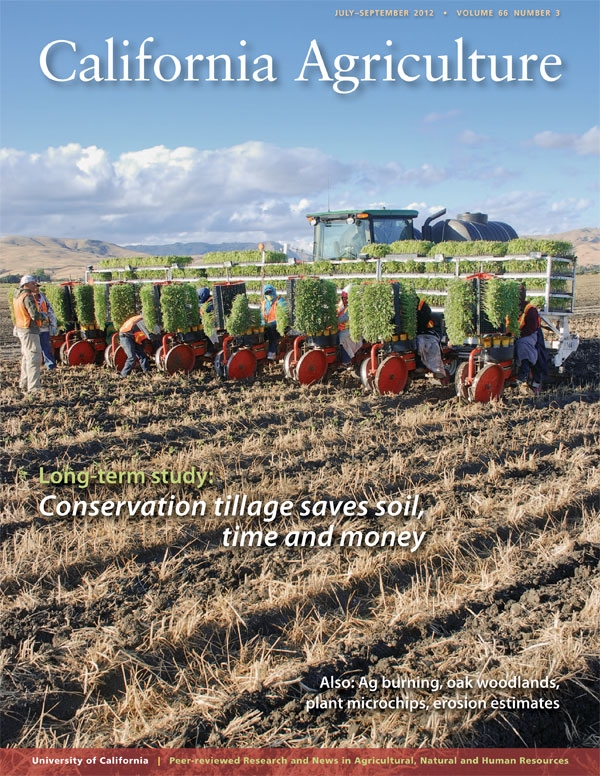
Conservation tillage seeks to reduce the number of times that tractors cross the field, in order to protect the soil from erosion and compaction, and save time, fuel and labor costs. Cotton crops are planted directly into stubble from the previous crop in the rotation.
In the study, conducted from 2000 to 2011 at the UC West Side Research and Extension Center in Five Points (southwest of Fresno), the number of tractor passes for a cotton-tomato rotation grown with a cover crop was reduced from 20 in the standard treatment to 13 with conservation tillage.
By the final years of the in the San Joaquin Valley study, cotton lint yields were statistically equivalent and even higher (in 2011) than with standard cultivation methods.
“The UC studies have consistently shown that conservation tillage can yield as well as standard tillage in a cotton-tomato rotation,” lead author Jeffrey P. Mitchell, UC Cooperative Extension specialist in the Department of Plant Sciences at UC Davis, and co-authors wrote in California Agriculture journal.
Their study, “Conservation tillage systems for cotton advance in the San Joaquin Valley,” as well as the entire July-September 2012 issue of California Agriculture journal, can be viewed and downloaded online at: http://californiaagriculture.ucanr.edu.
Mitchell is a founder of Conservation Agriculture Systems Innovation (CASI), a diverse group of more than 1,800 farmers, industry representatives, UC and other university faculty, and members of the Natural Resources Conservation Service and other public agencies (http://ucanr.edu/CASI). CASI defines conservation tillage as a suite of cultivation practices — including no-tillage, minimum tillage, ridge tillage and strip tillage — that reduce the volume of soil disturbed and preserve crop residues in the field. Conservation tillage is common in other regions of the United States and parts of the world and is beginning to gain acceptance in California agriculture.
Technological upgrades to tillage implements have been critical to the advancement of conservation tillage systems. These include equipment that can target operations to just the plant row rather than the whole field as well as accomplish several operations at the same time.
Fuel use was reduced by 12 gallons and labor by 2 hours per acre in the conservation tillage plots. This amounted to savings of about $70 per acre in 2011 dollars.
Mitchell noted that more research is needed on the adequate development of cotton stands and the prevention of soil compaction under different conditions, but that the benefits of conservation tillage are becoming increasingly obvious. “Provided that yield performance or more importantly bottom-line profitability can be maintained and the risks associated with adopting a new tillage system are deemed reasonable, conservation tillage systems may become increasingly attractive to producers and more common in San Joaquin Valley cotton-growing areas.”
Also in the July-September 2012 issue of California Agriculture:
Agricultural burning and air quality: Southern California farmers in Imperial County regularly burn crop residues of bermudagrass in the winter and wheat stubble in the summer. A study of ambient air quality adjacent to and downwind of agricultural burning sites in the desert county found that particulate matter levels (PM2.5) were 23% higher on burn days than on no-burn days at four locations. Researchers from the California Department of Public Health also assessed community educational needs regarding agricultural burning and developed fact sheets in English and Spanish targeting the general public, schools and farmers.
The value of privately owned oak woodlands: More than 80 percent of California’s 5 million oak woodland acres are privately owned. In a survey, researchers from Spain and UC Berkeley asked private owners of California oak woodlands to place a monetary value on amenities from their land such as recreation, scenic beauty or a rural lifestyle. The technique, called “contingent valuation,” found that landowners would be willing to pay $54 per acre annually for private amenities from their land and that their willingness to pay per acre decreased as their property size increased.
Microchips for woody plants: Radio-frequency identification (RFID) tags are widely used to track books in libraries, products during manufacturing, cattle from rangeland to the slaughterhouse, inventory in retail, runners in road races and much more. These tiny microchips (often the size of a grain of rice) are now being placed in woody plants such as grapevines and orchards to monitor crop diseases, track irrigation and pesticide applications, and help prevent the theft of valuable plants. In this review, Italian researchers discuss the emerging uses of RFID technology in agriculture.
Rainfall simulators to measure erosion: In their efforts to keep Lake Tahoe clear, researchers have been studying the movement of sediments into the lake using rainfall simulators. These fairly simple machines are placed on a slope; “rain” is created over a small frame, which allows sediment in the runoff to be collected and measured. However, the lack of standardization in erosion studies using rainfall simulators may be hampering progress. Mark Grismer, professor in the Department of Land, Air and Water Resources at UC Davis, makes the case for standardized field methodologies and data analysis.
###
California Agriculture is the University of California’s peer-reviewed journal of research in agricultural, natural and human resources. For a free subscription, go to: http://californiaagriculture.ucanr.edu, or write to calag@ucanr.edu.
WRITERS/EDITORS: To request a hard copy of the journal, e-mail jlbyron@ucanr.edu.